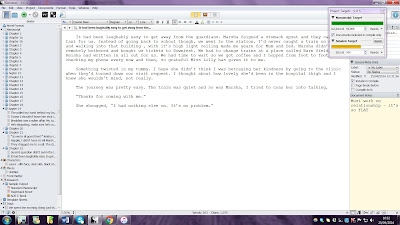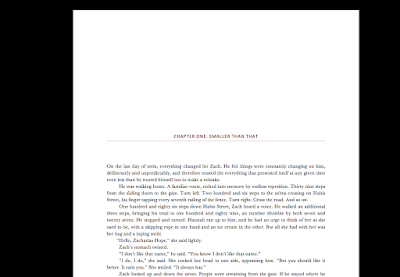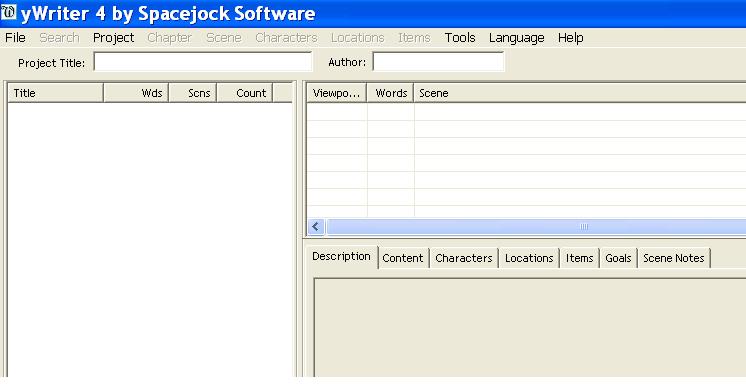| Thanks giphy.com |
A writer can scribe on anything - if you have an idea and you're anything like me, you've probably scrawled stuff down on napkins, the back of your hand and old bus tickets. None of these are very practical though - and you'd probably struggle to write a novel on them. I used to write mainly in Word, with a notebook by my side to make notes as I went. Then I discovered writer's software. For the disorganised amongst us ( me) it's an absolute godsend.
Scrivener is my software of choice but I've drafted in a little help from Jo Wyton, to speak up for Word, and Philippa Francis for yWriter. If you're a fan of something else, please let us know the pros and cons, and where you can get hold of it, in the comments!
Price range:
Platforms it works on: Windows only.
Available support: Not sure how good the support is but there isn't much to go wrong - if you can answer this please add to the hive mind in the comments!
How do you use it:
 |
| An old Kathryn Evans script on yWriter 5 |
Pros then?
Cons?
Kathryn Evans on Scrivener
Price range:
You can download a free trial for 30 days and it only counts the days you actually use it. To buy the full version is $40, forever.
It's worth giving it the full time trial. I'd forgotten this until I looked up my blog from four years ago
So much so that I'm a complete convert.The 30 day trial period is about right. It took me a while to love this piece of software. I resented it in the way I used to resent tidying my room. Slowly, however, I learned to appreciate it.
Platforms it works on: Mac and Windows - there is a version in the pipeline for iPad but it's been a long time coming and no real sign yet.
Available support: Excellent - it might take a day but they respond to email and will always help - there's also some brilliant forums where you can quite often find answers to your questions.
How do you use it:
I now write, and edit, my whole novels in it. It's very easy to divide each chapter into scenes, add notes to the side, even pictures and character notes. I'm lazy with it really - I coudl and should use it better - by giving my scenes titles, for example, I could more easily manage a structural edit - even so, it's clear to see and overview. Once I need to send it to my agent and/or editor, I compile the document and move it to word. I do all future edits in Word but this is mostly because they don't use Scrivener and it's easier to work with their tracked changes where they are.
 |
| My current WIP in Scrivener |
Pros then?
I find it intuitive to use but if you don't, the tutorials are easy to follow. Heaps of useful content and ways to use it. The word count / target word count box is invaluable. It's great for the more disorganised amongst us (me) and it looks nice too!
Cons?
There is a lot of potentially useful content that I don't access because I can't be bothered to work it out. Not really a con of Scrivener.
Jo Wyton on Word.
Platforms it works on: Windows and Mac (for reference, I'm a Mac user)
Available support: Like with Scrivener, although probably to an even greater extent, there are forums galore for software support.
How do you use it:
Pros then?
I already know how to use it, so there's no time spent learning the how. It also makes it unbelievably easy to transfer files between computers to work on. For example, I have a desktop Mac as well as a notebook, and having things in Word just makes it so easy. I can also transfer to Windows computers for printing etc without worrying about having to reformat. I also love the 'full screen' mode, which is similar to Scrivener in that it block all else from your screen, has changeable backgrounds, etc.
Cons?
Some might find it overly simple for building a manuscript in. But for me, the simplicity is its main draw.
So there you go - I have to say I would REALLY miss Scrivener if I didnt' have it. I broke the target word count last week and it drove me crazy not having it - it was like all the words I was writing didn't even count. Thank goodness for the support forums, once I'd fixed it I had a lovely ( 2000+ word) surprise.
Conclusion? If you've got an untidy brain , writer's software that can take you to a whole new level of organisation is really worth it. Do add your own experiences in the comments - it all adds to the hive mind!
Special thanks to Jo Wyton and Philippa Francis, aka K M Lockwood
Kathryn Evans is a stalwart SCBWI member. She tweets @mrsbung and hangs about on instagram kathrynevansauthor. She's got a book out too,: More of Me was published by Usborne in February 2016.






I’ve heard a lot about dropbox and want to look into it. I use Scrivener which I believe is similar to ywriter. And I use my Kindle to read my own work and beta reads. Except, I just email the doc straight to the Kindle and it turns out fine for my purposes.
Yep, another Scrivener lover. Great to hear that yWriter has worked so well for you. I also use Mind Manager, which is mind mapping software. I have a map for each of my wips, as well as for new writing ideas and my blog. Anytime I get a new idea, or figure out something for a wip, I put it in the mind map. It’s a little time consuming, but much less time consuming than flipping through hundreds of notebook pages.
I tried Scrivener for awhile … I’m still on the fence about it. I figure I’ll try it for my next project (from the start, rather than half way through) and see what I think. I like using Write or Die when I really need to crank some words out.
I don’t use any gadgets. Other than Word, I haven’t tried anything. I should check these out.
If you get a chance, please visit my blog. I’m holding a 500 follower contest. Great prizes!
I’m a pen and paper kind of gal but I have to admit, I’m intrigued by these! Especially yWriter5. I’m going to have to check that out. Thanks for the heads up.